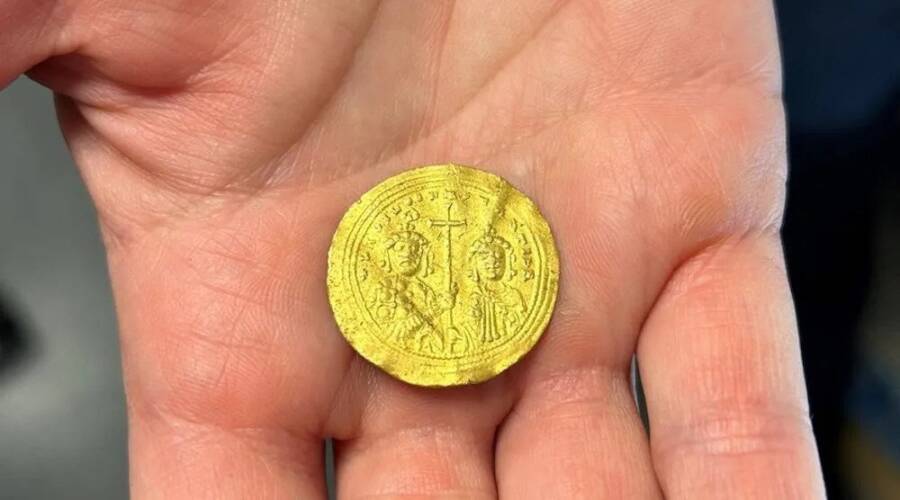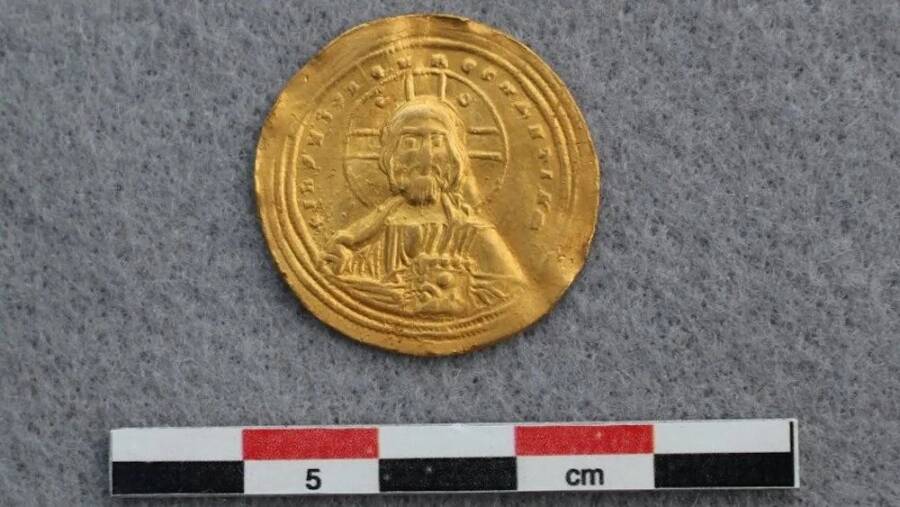The coin has a depiction of Jesus Christ on one side and Basil II and Constantine VIII, rulers of the Byzantine Empire, on the other.

Martine Kaspersen, Innlandet FylkeskommuneThough found in Norway, the coin was minted some 1,600 miles away in the Byzantine Empire.
Around 1,000 years ago, a remarkable gold coin with a depiction of Jesus Christ somehow made its way from the Byzantine Empire to Norway. Lost for centuries, it was just found by a metal detectorist in Vestre Slidre, a mountainous region in Norway’s Innlandet County known for skiing.
“We receive many great finds from detectorists, but now a particularly special find has come in,” the Innlandet County Municipality exclaimed in a translated statement. “We are talking about a very rare Byzantine histamenon nomisma.”
This “histamenon nomisma” is a gold coin that was introduced in the Byzantine Empire around 960 C.E. One side depicts Jesus Christ holding the Bible; the other side shows an image of Basil II and Constantine VIII, two brothers who ruled the Byzantine Empire near the end of the 9th century.
In addition to the imagery, the coin also has two inscriptions. One written in Latin says: “Jesus Christ, King of those who reign,” and one written in Greek says: “Basil and Constantine, emperors of the Romans.”
“It has held up exceptionally well,” the statement said. “The coin appears largely unchanged from when it was lost, perhaps a thousand years ago.”
The histamenon nomisma was likely minted sometime between 977 C.E. and 1025 C.E. in the Byzantine Empire, also known as the Eastern Roman Empire, likely in Constantinople (present-day Istanbul).

Martine Kaspersen, Innlandet FylkeskommuneOne side of the coin depicts Jesus Christ and the Bible.
But how did the coin get from the Byzantine Empire to Norway?
Researchers speculated that the answer might lie with Harald Hardrada, a Norwegian king who ruled from 1045 to 1066.
Before he took power, Hardrada served alongside other North Europeans as a bodyguard for three Byzantine emperors. As the statement notes, guards like Hardrada traditionally looted the palace every time an emperor died, and Hardrada was present for the deaths of three emperors. Thus, it’s possible that he picked up the coin during one such rampage.
Such a coin may have been part of a dowry that Hardrada sent to Prince Yaroslav in Kyiv so that he could marry one of the royal daughters.

Wikimedia CommonsA depiction of Harald Hardrada.
However, it’s also possible that the coin made its way to Norway another way. It could have been picked up and lost by a clergyman in Vestre Slidre, or it may have been used to facilitate trade of “salt and herring from the west, and iron ingots, reindeer skins and antlers from the east.”
Indeed, many questions about the coin remain. And researchers are eager to learn more. Because the histamenon nomisma was discovered in late autumn, however, archaeologists won’t be able to return to the site until 2024. Then, perhaps, they’ll unearth even more treasures.
In the meantime, the discovery of the coin stands as just one of many incredible finds made by metal detectorists in Norway this year. Previously, a Norwegian man who picked up a metal detector as a way to get more exercise stumbled across the “gold find of the century” when he uncovered a cache of nine gold pendants, three gold rings, and 10 gold pearls that once formed a necklace around 1,500 years ago.
With a metal detector and a little luck, who knows what you may find.
After reading about the Byzantine gold coin with the “face of Jesus” that was found in Norway, see how a metal detectorist in England came across a pendant celebrating Henry VIII’s marriage to Katherine of Aragon. Or, discover how another metal detectorist came across a gold pendant with the oldest known reference to Odin in a Danish field.





